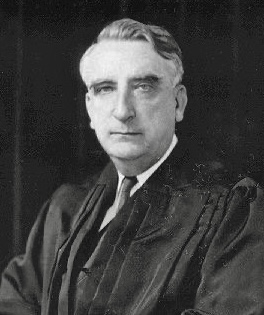| Vinson Court | |
|---|---|
| June 24, 1946 – September 8, 1953 (7 years, 76 days) | |
| Seat | Supreme Court Building Washington, D.C. |
| No. of positions | 9 |
| Vinson Court decisions | |
 | |
This is a partial chronological list of cases decided by the United States Supreme Court during the Vinson Court, the tenure of Chief Justice Frederick Moore Vinson from June 24, 1946 through September 8, 1953.
| Case name | Citation | Summary |
|---|---|---|
| United States v. Carmack | 329 U.S. 230 (1946) | land held by a local government is still subject to eminent domain by the federal government |
| Louisiana ex rel. Francis v. Resweber | 329 U.S. 459 (1947) | Attempting a second electrocution after the first fails does not violate the 8th or 5th Amendment. |
| Hickman v. Taylor | 329 U.S. 495 (1947) | work-product doctrine |
| Everson v. Board of Education | 330 U.S. 1 (1947) | First Amendment, establishment of religion |
| U.S. Public Workers v. Mitchell | 330 U.S. 75 (1947) | Hatch Act of 1940 |
| United States v. United Mine Workers | 330 U.S. 258 (1947) | injunction against a strike action |
| Crane v. Commissioner | 331 U.S. 1 (1947) | determination of basis of property secured by a nonrecourse mortgage |
| Adamson v. California | 332 U.S. 46 (1947) | Fifth Amendment, incorporation |
| International Salt Co. v. United States | 332 U.S. 392 (1947) | tying arrangements under the Sherman Act |
| Cox v. United States | 332 U.S. 442 (1947) | scope of review for Jehovah's Witness classified as conscientious objector |
| Sipuel v. Board of Regents of Univ. of Okla. | 332 U.S. 631 (1948) | Fourteenth Amendment, segregation |
| Oyama v. California | 332 U.S. 633 (1948) | California Alien Land Laws, equal protection under the Fourteenth Amendment |
| Woods v. Cloyd W. Miller Co. | 333 U.S. 138 (1948) | War Powers Clause |
| McCollum v. Board of Education | 333 U.S. 203 (1948) | Separation of church and state, constitutionality of released time in public schools |
| Shelley v. Kraemer | 334 U.S. 1 (1948) | equal protection, racial covenants |
| United States v. Paramount Pictures, Inc. | 334 U.S. 131 (1948) | Hollywood studios monopoly |
| Takahashi v. Fish and Game Commission | 334 U.S. 410 (1948) | statute denying commercial fishing licenses to aliens ineligible for citizenship held to violate Equal Protection Clause |
| Saia v. People of the State of New York | 334 U.S. 558 (1948) | ordinance which prohibited the use of sound amplification devices except with permission of the Chief of Police violates First Amendment |
| United States v. National City Lines Inc. | 334 U.S. 573 (1948) | General Motors streetcar conspiracy |
| United States v. Congress of Industrial Organizations | 335 U.S. 106 (1948) | Labor union's publication of statement urging members to vote for a certain candidate for Congress did not violate Taft-Hartley Act |
| Goesaert v. Cleary | 335 U.S. 464 (1948) | Upholding employment restrictions against female bartenders |
| H.P. Hood & Sons v. Du Mond | 336 U.S. 525 (1949) | Dormant Commerce Clause |
| Terminiello v. Chicago | 337 U.S. 1 (1949) | free speech and public order |
| United States v. Interstate Commerce Commission | 337 U.S. 426 (1949) | justiciability |
| Wheeling Steel Corp. v. Glander | 337 U.S. 562 (1949) | Fourteenth Amendment due process, Commerce Clause |
| Wolf v. Colorado | 338 U.S. 25 (1949) | Fourteenth Amendment, state court, evidence from unreasonable search and seizure |
| Hirota v. MacArthur | 338 U.S. 197 (1948) | the United States federal courts lacked the authority to review judgments of the International Military Tribunal for the Far East |
| Mullane v. Central Hanover Bank & Trust Co. | 339 U.S. 306 (1950) | proper legal notice in the settlement of a trust |
| Graver Tank & Manufacturing Co. v. Linde Air Products Co. | 339 U.S. 605 (1950) | patent law, doctrine of equivalents |
| Sweatt v. Painter | 339 U.S. 629 (1950) | segregation, separate but equal |
| McLaurin v. Oklahoma State Regents | 339 U.S. 637 (1950) | Fourteenth Amendment, segregation |
| Johnson v. Eisenträger | 339 U.S. 763 (1950) | jurisdiction of U.S. civilian courts over nonresident enemy aliens; habeas corpus |
| Henderson v. United States | 339 U.S. 816 (1950) | ending segregation in railroad dining cars |
| Feres v. United States | 340 U.S. 135 (1950) | Military exception to government liability under the Federal Tort Claims Act |
| Kiefer-Stewart Co. v. Seagram & Sons, Inc. | 340 U.S. 211 (1951) | agreement among competitors in interstate commerce to fix maximum resale prices of their products violates the Sherman Act |
| Kunz v. New York | 340 U.S. 290 (1951) | free speech restrictions must be "narrowly tailored" |
| Feiner v. New York | 340 U.S. 315 (1951) | Free speech v. public safety—decided same day as Kunz v. New York |
| Dean Milk Co. v. City of Madison, Wisconsin | 340 U.S. 349 (1951) | Dormant Commerce Clause |
| Universal Camera Corp. v. NLRB | 340 U.S. 474 (1951) | judicial review of agency decisions |
| Canton Railroad Company v. Rogan | 340 U.S. 511 (1951) | Maryland's franchise tax on imported and exported goods held not to violate the Import-Export Clause of the United States Constitution |
| Joint Anti-Fascist Refugee Committee v. McGrath | 341 U.S. 123 (1951) | freedom of association |
| Dennis v. United States | 341 U.S. 494 (1951) | First Amendment and the Smith Act |
| Stack v. Boyle | 342 U.S. 1 (1951) | defines excessive bail |
| Rochin v. California | 342 U.S. 165 (1952) | restriction of police power |
| Morissette v. United States | 342 U.S. 246 (1952) | strict liability offenses |
| Dice v. Akron, Canton & Youngstown R. Co. | 342 U.S. 359 (1952) | reverse Erie doctrine, federal standard binding on state court |
| Perkins v. Benguet Mining Co. | 342 U.S. 437 (1952) | general personal jurisdiction over a business that was temporarily based in the court's jurisdiction |
| Frisbie v. Collins | 342 U.S. 519 (1952) | kidnapping of fugitives by state officials is constitutional |
| Ray v. Blair | 343 U.S. 214 (1952) | states' rights in the electoral college |
| Beauharnais v. Illinois | 343 U.S. 250 (1952) | First Amendment and "group libel" |
| Zorach v. Clauson | 343 U.S. 306 (1952) | release time programs |
| Public Utilities Commission of the District of Columbia v. Pollak | 343 U.S. 451 (1952) | First and Fifth Amendment and street car playing music |
| Joseph Burstyn, Inc. v. Wilson | 343 U.S. 495 (1952) | First Amendment and the censorship of films |
| Youngstown Sheet & Tube Co. v. Sawyer | 343 U.S. 579 (1952) | presidential power to seize steel mills during strike to ensure wartime production |
| Kawakita v. United States | 343 U.S. 717 (1952) | treason accusation against a person with dual citizenship. |
| Arrowsmith v. Commissioner | 344 U.S. 6 (1952) | Taxpayers classified a payment as an ordinary business loss, which would allow them to take a greater deduction for the loss than would be permitted for a capital loss |
| United States v. Reynolds | 345 U.S. 1 (1953) | State secrets privilege |
| Fowler v. Rhode Island | 345 U.S. 67 (1953) | ordinance construed to penalize a minister of Jehovah's Witnesses for preaching at a peaceful religious meeting in a public park unconstitutional |
| Poulos v. New Hampshire | 345 U.S. 395 (1953) | religious meetings and the Free Exercise Clause |
| Securities and Exchange Commission v. Ralston Purina Co. | 346 U.S. 119 (1953) | a corporation offering "key employees" stock shares is still subject to Section 4(1) of the Securities Act of 1933 |











